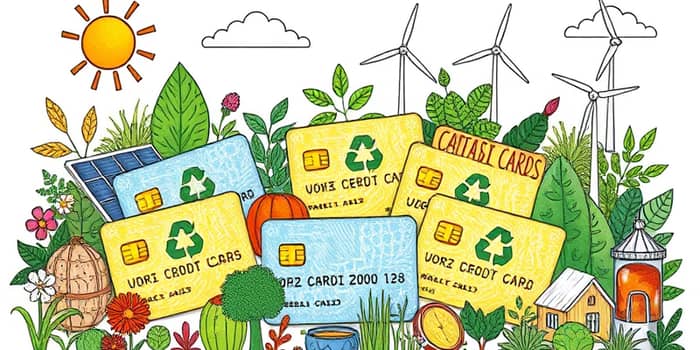Every purchase we make carries weight beyond its price tag. In an era of growing environmental awareness, consumers are seeking financial tools that align with their values. Sustainable credit cards transform everyday spending into a force for good, blending modern convenience with a commitment to our planet.
By choosing the right card, you can support green initiatives, reduce waste, and even earn rewards for eco-conscious habits. This guide will help you navigate the landscape of sustainable credit cards, understand their benefits, and select the option that fits your lifestyle.
Understanding Eco-Friendly Credit Cards
Eco-friendly credit cards distinguish themselves through innovative features designed to minimize environmental impact and promote responsible consumption. These cards often emphasize three core elements:
- sustainable materials like recycled plastic or alternative substances such as wood and bio-sourced polymers
- carbon offset programs and donations that channel a portion of your spending toward renewable energy or conservation efforts
- reward structures that encourage incentivizing eco-conscious consumer spending on public transit, electric vehicle charging, and plant-based products
- paperless digital statements and communications to eliminate unnecessary waste
When combined, these features create a card that goes beyond simple transactions, fostering a culture of sustainability.
Environmental Impact of Traditional Cards
Credit cards have a hidden ecological footprint. The production of 3.5 billion banking cards each year releases a carbon footprint equivalent to 288,000 passengers flying from New York to Sydney. Moreover, the annual mass of PVC plastic used would weigh as much as 95 Boeing 747 airplanes. Once they reach end of life, many cards end up in landfills, where plastic degrades into microplastics without ever fully returning to nature.
Amid these stark figures, sustainable credit cards offer a tangible way for individuals to reduce their environmental impact through everyday actions.
Types of Sustainable Card Materials
Eco-conscious issuers are innovating rapidly to replace conventional PVC. Here are the most common alternative materials:
Wood cards utilize certified sustainable timber, offering a unique aesthetic and biodegradability. Ocean Plastic® cards are crafted from plastic reclaimed from coastal areas, removing waste that would otherwise harm marine life. Bio-sourced PLA cards derive from plant-based polymers, creating a card that can decompose under industrial composting conditions. Recycled PVC cards give a second life to existing plastic, reducing demand for virgin materials.
Benefits of Going Green with Your Card
Switching to an eco-friendly credit card offers a trifecta of advantages:
- reduced carbon footprint and environmental impact through lower-emission materials and donations to green causes
- incentivizing eco-conscious consumer spending with enhanced rewards for sustainable purchases
- enhanced social responsibility by supporting banks that prioritize ethics over fossil fuel investments
These benefits extend beyond the environment. You’ll gain access to competitive rewards and feel confident your financial choices reflect your values.
Challenges and Considerations
Even sustainable cards are not without limitations. Recycled plastics can only be processed once or twice before degrading, potentially releasing microplastics. Bio-sourced materials require industrial composting facilities for proper disposal, which may not be widely available. Additionally, balancing rewarding rates, annual fees, and other card features remains a personal decision.
Weigh these trade-offs carefully to ensure your chosen card aligns with both your ecological goals and financial needs.
Leading Examples of Eco-Friendly Credit Cards
Several issuers are pioneering the sustainable card movement. Below is a snapshot of standout options:
How to Choose the Right Sustainable Card
Selecting the ideal card involves more than green credentials—you need practical benefits too. Consider these tips:
- Ensure the card aligns with your spending habits by offering higher rewards where you spend most
- Compare annual fees and look for minimum fees and competitive rates to avoid hidden costs
- Check how and where the issuer channels donations or offsets carbon
- Verify that materials are truly recyclable or compostable in your region
- Assess customer service quality and additional perks like travel insurance or purchase protection
The Future of Sustainable Finance
The finance industry is awakening to consumer demand for environmental accountability. Banks are signing on to the Principles for Responsible Banking, and new regulations are encouraging greener practices. We can expect cards to evolve with biodegradable components with contactless technology, improved recycling programs, and deeper integration with carbon tracking apps.
As these innovations gain momentum, your everyday spending can become a powerful driver of change.
Embracing a sustainable credit card is more than a trend—it’s a commitment to shaping a healthier planet. By understanding the options, weighing the benefits and limitations, and choosing a card that meets your needs, you turn every transaction into an act of stewardship. Together, small changes in our wallets can yield monumental strides toward a greener future.
References
- https://www.nerdwallet.com/article/credit-cards/eco-friendly-credit-cards-what-do-they-promise-can-they-deliver
- https://www.nttdatapay.com/blog/eco-friendly-payment-cards/
- https://www.cnet.com/personal-finance/credit-cards/eco-friendly-credit-cards-let-you-earn-rewards-while-helping-the-environment/
- https://www.thalesgroup.com/en/markets/digital-identity-and-security/banking-payment/cards/eco-friendly-credit-card
- https://www.outlookmoney.com/banking/green-credit-cards-invest-in-eco-friendly-tomorrow-with-every-swipe
- https://www.joinkudos.com/blog/eco-friendly-credit-cards-can-your-spending-habits-save-the-planet
- https://www.spintheglobeproject.com/ethical-banks-and-socially-responsible-credit-cards/
- https://www.joinatmos.com/blog/what-are-eco-friendly-debit-cards-and-credit-cards










